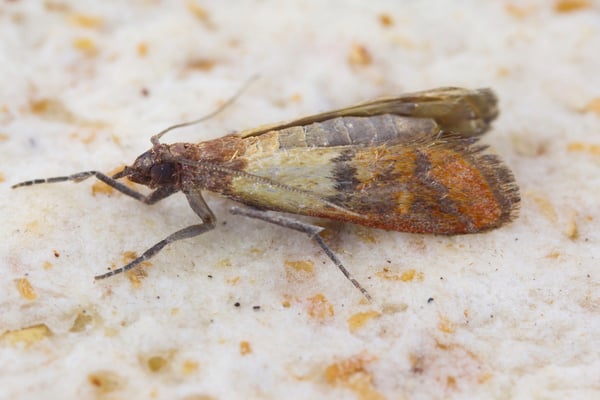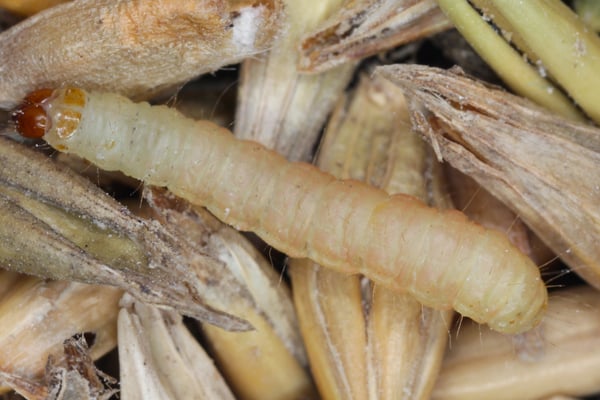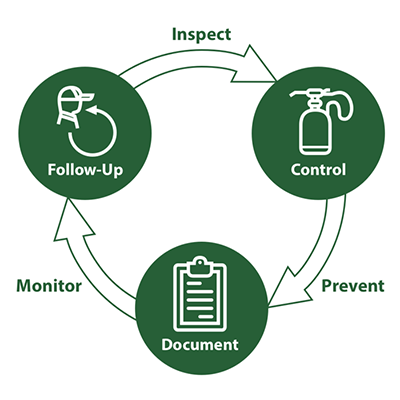Indian Meal Moth
Appearance And Behavior
Early American entomologist Asa Fitch named the Indian meal moth when he saw one feeding on cornmeal (Indian meal). Today, the Indian meal moth (Plodia interpunctella) is one of the most commonly-encountered stored product pests in the US. Originally of Old World origin, it can now be found worldwide.
Indian meal moths have a body length of 1/4 to 3/8 inches long, with a wingspan of about 3/4 inches long. Their front wings are bi-colored: the upper third of the wings are a light beige, while the outer parts are copper or bronze-colored. It may look like the moths have white “spots” near the top of their bodies, around their heads. An adult moth’s thin body is the same copper-bronze color as the outer wings.
Mature larvae are usually about ½ an inch long and off-white in color. They may also vary to a greenish, pinkish or brownish hues depending on the food they ingest. The head and thorax surface behind the larva’s head is a distinctive yellowish-brown.
The speed of Indian meal moths’ development cycle depends on the temperature of their environment. On average, the moth’s entire life cycle from egg to adult usually only takes 40 to 55 days. In ideal circumstances (consistent food source, temperatures above 50℉), it could complete in as few as 28 days. Indian meal moths reproduce all year, but they’re less active in winter.
Female Indian meal moths lay between 100 and 300 eggs on or inside food sources. These eggs hatch within 1 to 18 days. After they hatch, larvae immediately burrow into food sources and eats continuously. The moths’ larval period can last for most of their lives. Eventually, they will pupate within a silk cocoon for a short period of time before re-emerging as adults. After their pupation, adult moths leave their food sources behind to mate and lay eggs. Adult moths can’t eat and never live long.

Indian meal moths inflict their damage during their larval stage. The larvae carve shallow burrows into food while producing a thin, waxy silk webbing. Indian meal moth larvae aren’t picky eaters; they’ll attack a wide variety of common dry foods. In homes, they commonly infest grain products, dried fruit, seeds, nuts, graham crackers, granola, powdered milk, biscuits, chocolate, dry dog food, and bird seed.
They’re particularly destructive wherever dried fruits are stored. When larvae wander around looking for pupation sites in homes, they are often mistaken for clothes moth larvae. Likewise, the adult moths are often mistaken for clothes-eating moths. Unlike clothes moths, however, Indian meal moths will infest your pantry or food storage areas–never your closets. Adult Indian meal moths are attracted to light.
Indian Meal Moth Prevention

The first step to stopping an Indian meal moth infestation is locating and removing food sources they’ve infested. Look for burrows on the surface of dry, soft food and a thin coating of waxy silk. You may find larvae burrow beneath the surface of breads, grains, or fruits. You should also keep an eye out for the moth’s small, cylindrical eggs.
Remove moths, larvae, and cocoons using a vacuum cleaner hose attachment. Make sure you throw out the vacuum bag when you’re finished. After removing the moths, be sure to store dry foods in airtight, hard plastic containers. Clean your pantry, dining, and food prep areas quite regularly, and don’t let crumbs accumulate!
Indian Meal Moth Control Process
A Plunkett’s pest management professional will start treating Indian meal moths by locating and cleaning out Indian meal moth breeding locations. We’ll find infested food, clean the infestation site, and figure out how pests got inside in the first place. Then, we’ll help you figure out how you can prevent infestations from occurring again.
In some circumstances, we may apply residual insecticide dust to cracks, crevices, infested structural voids, or other access points. This dust will help prevent repeat infestations after we’ve gone. We may also apply insecticide aerosol formulations to stop additional Indian meal moth breeding when necessary.
If you’re worried that you have an Indian meal moth problem, call Plunkett’s Pest Control right away. We have the tools, knowhow, and experience to solve your moth pest problem, no matter how severe. We’ll keep your pantry safe!

Indian Meal Moth Control With Plunkett's
At Plunkett’s, our goal is to help you quickly, conveniently, and in the most cost-effective way. We make every effort to be with you asap, usually within a day or two.
Learn More
There are a good number of stored product pests that are particularly likely to make pests of themselves around your home. Some of the most common examples of stored product pests Plunkett’s encounters frequently include:






